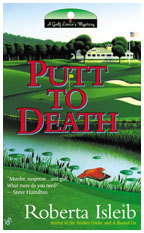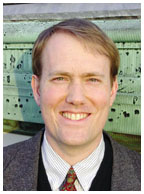June 9, 2004: Reading Room
W. Barksdale Maynard ’88 says the greatest threat to Walden Pond today is overuse. (Susan E. Matsen) |
Walden:
More than a pond
W. Barksdale Maynard ’88 writes a history
of an American shrine
By Maurice Timothy Reidy ’97
Made famous by Henry David Thoreau in the 19th century, Walden Pond has been called an international shrine and the birthplace of the environmental movement. There’s something about the pond and the surrounding woods that stirs the American imagination; every year, over 700,000 people visit Walden’s placid shores to catch a glimpse of what Thoreau once called “the wild luxuriant beauty of Nature.”
The story of this pond — really a 60-acre lake — on the outskirts of Boston is the subject of W. Barksdale Maynard ’88’s Walden Pond: A History, published by Oxford in March. It is the first book about the pond since Thoreau wrote Walden 150 years ago.
A professor of architectural history at Johns Hopkins University and a Thoreau devotee, Maynard traces the role the pond has played in America’s cultural, social, and literary history. A staggering amount has been written about Thoreau, says Maynard, but relatively little about the pond itself. The goal of the book is to “pull back the lens” and explore the places Thoreau cherished.
 Thoreau
first visited the pond as a child in 1821 and later returned at the age
of 27, in his words, “to live deliberately, to front only the essential
facts of life.” Thoreau was one of a number of writers who sought
solitude in Walden Woods. Ralph Waldo Emerson moved near the pond in 1835
to get closer to nature. He wrote about his walks through Walden Woods
in Nature, a book that became a cornerstone of the environmental
movement.
Thoreau
first visited the pond as a child in 1821 and later returned at the age
of 27, in his words, “to live deliberately, to front only the essential
facts of life.” Thoreau was one of a number of writers who sought
solitude in Walden Woods. Ralph Waldo Emerson moved near the pond in 1835
to get closer to nature. He wrote about his walks through Walden Woods
in Nature, a book that became a cornerstone of the environmental
movement.
Maynard describes the geography of the pond and the battles to save the surrounding woods from development. The area around Walden has changed considerably since the 1830s. Concord, where the pond is located, is now an affluent suburb of Boston. In the 1980s, rocker Don Henley’s Walden Woods Project fought off proposals to build around the pond, including one idea to erect an office park on a nearby hill.
An art history major at Princeton, Maynard first visited Walden in the summer after his sophomore year. The pond has fascinated him ever since.
Maynard, who earned a Ph.D. in art history at the University of Delaware and has been a consultant to the Walden Woods Project and a visiting scholar at the Thoreau Institute at Walden Woods, spent two-and-a-half years researching Walden Pond. Part of that time he observed the visitors to the pond, from the early morning fisherman to the thousands who flock to its beaches in the summer. Today, Maynard says the greatest danger facing the pond is overuse. “We could have 100 million people coming to the pond this century and they could literally trample it to death,” he says, suggesting that the number of visitors be limited.
“There is still beauty to be discovered at Walden,” Maynard
writes. “And there is something inspiring about the dogged persistence
of wildness here even as the modern world has surrounded the reservation
on all sides.” ![]()
Maurice Timothy Reidy ’97 is an associate editor at Commonweal magazine.
Roberta Isleib ’75 spent time with pro golfers at the U.S. Women’s Open for research on an upcoming book. (Courtesy Roberta Isleib ’75) |
Tee
times, mind games, and murder
Psychologist and golfer Roberta Isleib ’75
has other life as mystery writer
When Roberta Isleib ’75 was thinking about what direction to take for her third book in her murder-mystery series about an insecure but likable pro golfer, Cassie Burdette, she looked no further than her own Connecticut golf club and the goings-on at board of directors meetings.
A board member herself, Isleib had been pushing her club to adopt more environmentally friendly maintenance practices, like reducing the use of chemicals and pesticides, and conserving water — changes that would allow some weeds, clover, and other plants to grow on the course. When her proposal was voted down, “I was furious,” she says. She channeled her disappointment into her latest book, Putt to Death, published in April by Berkley Prime Crime, in which the character Brad Latham, who makes a similar proposal to his stodgy Stony Creek Country Club board of directors, is killed the next day.
 In Putt
to Death, Burdette, who is taking a break from the Ladies Professional
Golf Association tour and has become the club’s pro, finds Latham’s
body near the 7th hole. The protagonist has stumbled upon dead bodies
in the first two books in the series, Six Strokes Under (2002)
and A Buried Lie (2003). Burdette can’t help herself from
playing amateur sleuth at the same time that she’s trying to work
on her golf game and struggle with her own emotional baggage — including
her father’s abandonment and her poor choice in men — in psychotherapy
sessions. “She’s stuck in her love life and her professional
life,” says Isleib.
In Putt
to Death, Burdette, who is taking a break from the Ladies Professional
Golf Association tour and has become the club’s pro, finds Latham’s
body near the 7th hole. The protagonist has stumbled upon dead bodies
in the first two books in the series, Six Strokes Under (2002)
and A Buried Lie (2003). Burdette can’t help herself from
playing amateur sleuth at the same time that she’s trying to work
on her golf game and struggle with her own emotional baggage — including
her father’s abandonment and her poor choice in men — in psychotherapy
sessions. “She’s stuck in her love life and her professional
life,” says Isleib.
An avid golfer, Isleib draws on both her knowledge of the sport and her experience as a clinical psychologist. A French literature major at Princeton, Isleib earned a doctorate in psychology from the University of Florida in 1985. Her psychotherapy practice, which she gave up a year and a half ago to concentrate on writing, focused on exploring how family history and relationships shape people.
Psychologists also appear in her books. Burdette’s dependable friend, psychologist Joe Lancaster, appears in all three, using his skills as a therapist to help solve the mysteries. Isleib wanted to paint a realistic view of her profession. “When you look at psychologist characters, especially in the movies, they are either crazier than their patients or they’re sleeping with their patients or otherwise look ridiculous,” says Isleib.
To get the details right about the life of a professional golfer, Isleib has spent time with players and their families during tournaments and even participated in a two-day professional-amateur tournament. Her next book, Fairway to Heaven, will be published in 2005.
With a nod to her alma mater, Isleib introduces character Elizabeth
Weigel, who graduated during Princeton’s early years of coeducation,
in Putt To Death. But she doesn’t last long. Like Brad
Latham, Weigel pushes an unpopular agenda at the club’s board of
directors meeting: asking the club to allow women equal access to Saturday-morning
tee times and the grill room. She, too, is found dead, buried in the sand
on the 16th hole. ![]()
By K.F.G.
BOOK SHORTS
 Writing About
Your Life: A Journey into the Past — William Zinsser ’44
(Marlowe & Company). The author of the classic guide On Writing Well
(1976), Zinsser shows readers of his new book how to write about their
lives, by describing the people, places, and events of his own life. He
pauses between those stories to explain the technical decisions he made
in writing the tales. He advises readers: “Write about small, self-contained
incidents that are still vivid in your memory.” Zinsser teaches
at the New School in New York. Click
here to read an excerpt.
Writing About
Your Life: A Journey into the Past — William Zinsser ’44
(Marlowe & Company). The author of the classic guide On Writing Well
(1976), Zinsser shows readers of his new book how to write about their
lives, by describing the people, places, and events of his own life. He
pauses between those stories to explain the technical decisions he made
in writing the tales. He advises readers: “Write about small, self-contained
incidents that are still vivid in your memory.” Zinsser teaches
at the New School in New York. Click
here to read an excerpt.
 The Human Story:
Our History, From the Stone Age to Today — James C. Davis
’52 (HarperCollins). In fewer than 500 pages, Davis sweeps through
human history, from the emergence of Homo sapiens to the beginning of
the third millennium. He discusses how wandering peoples settled down,
founded cities, conquered neighbors, formed religions, and later how people
fought in two world wars and journeyed into space. Davis taught history
at the University of Pennsylvania for 34 years.
The Human Story:
Our History, From the Stone Age to Today — James C. Davis
’52 (HarperCollins). In fewer than 500 pages, Davis sweeps through
human history, from the emergence of Homo sapiens to the beginning of
the third millennium. He discusses how wandering peoples settled down,
founded cities, conquered neighbors, formed religions, and later how people
fought in two world wars and journeyed into space. Davis taught history
at the University of Pennsylvania for 34 years.
 A Cancer Survivor’s
Almanac: Charting Your Journey — edited by Barbara Hoffman
’80 (John Wiley and Sons). A guide to living with a cancer diagnosis,
this book provides information on treatments, healing strategies, how
to work with doctors, and social, financial, and legal issues faced by
cancer survivors. Hoffman is the founding chair of the National Coalition
for Cancer Survivorship and a professor at Rutgers University School of
Law, Newark.
A Cancer Survivor’s
Almanac: Charting Your Journey — edited by Barbara Hoffman
’80 (John Wiley and Sons). A guide to living with a cancer diagnosis,
this book provides information on treatments, healing strategies, how
to work with doctors, and social, financial, and legal issues faced by
cancer survivors. Hoffman is the founding chair of the National Coalition
for Cancer Survivorship and a professor at Rutgers University School of
Law, Newark.
 The Secret
Life of Lobsters: How Fishermen and Scientists Are Unraveling the Mysteries
of Our Favorite Crustacean — Trevor Corson ’91 (HarperCollins).
Combining popular science and social history, Corson, who worked for two
years as a sternman aboard a commercial lobster boat in Maine, explores
the life of a crusty Maine lobstering community and ecologists who study
the remarkable characteristics of lobsters. Corson is a journalist in
Boston.
The Secret
Life of Lobsters: How Fishermen and Scientists Are Unraveling the Mysteries
of Our Favorite Crustacean — Trevor Corson ’91 (HarperCollins).
Combining popular science and social history, Corson, who worked for two
years as a sternman aboard a commercial lobster boat in Maine, explores
the life of a crusty Maine lobstering community and ecologists who study
the remarkable characteristics of lobsters. Corson is a journalist in
Boston.
 Persuasions
of Fall — Ann Lauinger *77 (University of Utah). In this
collection of poetry, Lauinger heralds the everyday, from longing for
someone to observing a bug on a piece of fruit to the way light looks
at different times of the day. The author was awarded the Agha Shahid
Ali Prize in Poetry for this volume. Lauinger is a professor of literature
at Sarah Lawrence College.
Persuasions
of Fall — Ann Lauinger *77 (University of Utah). In this
collection of poetry, Lauinger heralds the everyday, from longing for
someone to observing a bug on a piece of fruit to the way light looks
at different times of the day. The author was awarded the Agha Shahid
Ali Prize in Poetry for this volume. Lauinger is a professor of literature
at Sarah Lawrence College.
 The Creation
of the Media: Political Origins of Modern Communications —
Paul Starr (Basic Books). A study of the shaping of communications in
Europe and the United States from the 17th to the mid-20th century, this
book looks at the intricately bound nature of politics and the media.
Starr argues that political decisions in America about such issues as
freedom of expression, intellectual property, and the ownership and architecture
of communications networks led to the media’s considerable power
in the United States. Starr is a professor of sociology.
The Creation
of the Media: Political Origins of Modern Communications —
Paul Starr (Basic Books). A study of the shaping of communications in
Europe and the United States from the 17th to the mid-20th century, this
book looks at the intricately bound nature of politics and the media.
Starr argues that political decisions in America about such issues as
freedom of expression, intellectual property, and the ownership and architecture
of communications networks led to the media’s considerable power
in the United States. Starr is a professor of sociology. ![]()
By Lucia S. Smith ’04
For a complete list of books received, go to PAW ONLINE: www.princeton.edu/paw.


